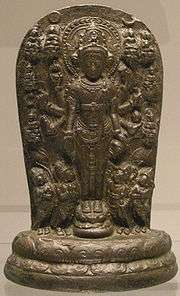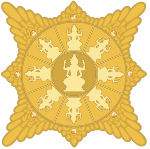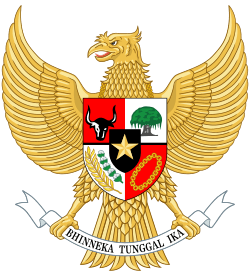Singhasari
Singhasari (Javanese: ꦏꦫꦠꦺꦴꦤ꧀ꦱꦶꦔ꧀ꦲꦱꦫꦶ, romanized: Karaton Singhasari or Karaton Singosari, Indonesian: Kerajaan Singhasari) was an Indianized Javanese Hindu–Buddhist kingdom located in east Java between 1222 and 1292. The kingdom succeeded the Kingdom of Kediri as the dominant kingdom in eastern Java. The kingdom's name is cognate to Singosari district of Malang Regency, located several kilometres north of Malang city.
Singhasari | |||||||||
|---|---|---|---|---|---|---|---|---|---|
| 1222–1292 | |||||||||
 Expansion of Singhasari during the reign of Kertanegara | |||||||||
| Capital | Tumapel, later called Kutaraja Singhasari (modern outskirt Malang) | ||||||||
| Common languages | Old Javanese, Sanskrit | ||||||||
| Religion | Kejawen, Hinduism, Buddhism, Animism | ||||||||
| Government | Monarchy | ||||||||
| Maharaja | |||||||||
• 1182–1227 | Ken Arok | ||||||||
• 1268–1292 | Kertanegara | ||||||||
| History | |||||||||
• Coronation of Ken Arok | 1222 | ||||||||
• invasion by Jayakatwang of Kediri | 1292 | ||||||||
| Currency | Native gold and silver coins | ||||||||
| |||||||||
Etymology
Singhasari (alternate spelling: Singosari) was mentioned in several Javanese manuscripts, including Pararaton. According to tradition, the name was given by Ken Arok during the foundation of the new kingdom to replace its old name, Tumapel, located in a fertile highland valley which today corresponds to the area in and around Malang city. It derives from Sanskrit word singha which means "lion" and sari which in Old Javanese could mean either "essence" or "to sleep". Thus Singhasari could be translated as "essence of lion" or "sleeping lion". Although the lion is not an endemic animal of Java, the symbolic depiction of lions is common in Indonesian culture, attributed to the influence of Hindu-Buddhist symbolism.
Foundation
Singhasari was founded by Ken Arok (1182-1227/1247), whose story is a popular folktale in Central and East Java. Most of Ken Arok's life story and also the early history of Singhasari was taken from the Pararaton account, which also incorporates some mythical aspects. Ken Arok was an orphan born of a mother named Ken Endok and an unknown father (some tales stated he was a son of god Brahma) in Kediri kingdom's territory.
Ken Arok rose from being a servant of Tungul Ametung, a regional ruler in Tumapel (present day Malang) to becoming ruler of Java from Kediri. He is considered the founder of the Rajasa dynasty of both the Singhasari and later the Majapahit line of monarchs.[1] He was assassinated by Anusapati, in revenge for killing his father, Tunggul Ametung.[2]:185–187 Ken Arok's son Panji Tohjaya assassinated Anusapati, but he in turn reigned only a few months in 1248 before his nephews revolted. These two, Ranga Wuni and Mahisha Champaka, ruled together under the names Vishnuvardhana and Narasimhamurti.[2]:188
Expansion
In the year 1275, the ambitious king Kertanegara, the fifth ruler of Singhasari who had been reigning since 1254, launched a peaceful naval campaign northward towards the weak remains of the Srivijaya[2]:198 in response to continuous Ceylon pirate raids and Chola kingdom's invasion from India which conquered Srivijaya's Kedah in 1025. The strongest of these Malaya kingdoms was Jambi, which captured the Srivijaya capital in 1088, then the Dharmasraya kingdom, and the Temasek kingdom of Singapore, and then remaining territories.
The expedition is named the Pamalayu expedition was led by Admiral Mahesa Anabrang (a.k.a. Adwaya Brahman) to the Malaya region, and was also intended to secure the Malayan strait, the ‘Maritime Silk Road’ against potential Mongol invasion and ferocious sea pirates. These Malayan kingdoms then pledged allegiance to the king. King Kertanegara had long wished to surpass Srivijaya as a regional maritime empire, controlling sea trade routes from China to India.
The Pamalayu expedition from 1275 to 1292, from the time of Singhasari to Majapahit, is chronicled in the Javanese scroll Nagarakrtagama. Singhasari's territory thus became Majapahit territory. In the year 1284, king Kertanegara made a hostile Pabali expedition to Bali, which integrated Bali into the Singhasari kingdom's territory. The king also sent troops, expeditions and envoys to other nearby kingdoms such as the Sunda-Galuh kingdom, Pahang kingdom, Balakana kingdom (Kalimantan/Borneo), and Gurun kingdom (Maluku). He also established an alliance with the king of Champa (Vietnam).
King Kertanegara totally erased any Srivijayan influence from Java and Bali in 1290. However, the expansive campaigns exhausted most of the Kingdom's military forces and in the future would stir a murderous plot against the unsuspecting King Kertanegara.
Conflict with the Mongol

Indonesia is one of the few areas in Asia that thwarted invasion by the Mongol horde by repelling a Mongol force in 1293. As the centre of the Malayan peninsula trade winds, the rising power, influence, and wealth of the Javanese Singhasari empire came to the attention of Kublai Khan of the Mongol Yuan dynasty based in China. Moreover, Singhasari had formed an alliance with Champa, another powerful state in the region. Both Java (Singhasari) and Champa were worried about Mongol expansion and raids against neighbouring states, such as their raid of Bagan (Pagan) in Burma.
Kublai Khan then sent emissaries demanding submission and tribute from Java. In 1280, Kublai Khan sent the first emissary to King Kertanegara, demanding Singhasari's submission and tribute to the great Khan. The demand was refused. The next year in 1281, the Khan sent another envoy, demanding the same, which was refused again. Eight years later, in 1289, the last envoy was sent to demand the same, and Kertanegara, refused to pay tribute.[2]:198
In the audition throne room of the Singhasari court, King Kertanegara humiliated the Khan by cutting and scarring Meng Ki's face, one of the Mongols' envoys (some sources even state that the king cut the envoy's ear himself). The envoy returned to China with the answer—the scar—of the Javan king written on his face.
Enraged by this humiliation and the disgrace committed against his envoy and his patience, in late 1292 Kublai Khan sent 1,000 war junks for a punitive expedition that arrived off the coast of Tuban, Java in early 1293.
King Kertanegara, whose troops were now spread then and located elsewhere, did not realise that a coup was being prepared by the former Kediri royal lineage.
Fall of Singhasari

In 1292, Regent Jayakatwang, a vassal king from the Kingdom of Daha (also known as Kediri or Gelang-gelang), prepared his army to conquer Singhasari and kill its king if possible, assisted by Arya Viraraja,[2]:199 a regent from Sumenep on the island of Madura.
The Kediri (Gelang-gelang) army attacked Singhasari simultaneously from both north and south. The king only realised the invasion from the north and sent his son-in-law, Nararya Sanggramawijaya, informally known as 'Raden Wijaya', northward to vanquish the rebellion. The northern attack was put at bay, but the southern attackers successfully remained undetected until they reached and sacked the unprepared capital city of Kutaraja. Jayakatwang usurped and killed Kertanagara during the Tantra sacred ceremony, thus bring an end to the Singhasari kingdom.
Having learned of the fall of the Singhasari capital of Kutaraja due to Kediri's treachery, Raden Wijaya tried to defend Singhasari but failed. He and his three colleagues, Ranggalawe, Sora and Nambi, went to exile under the favour of the same regent (Bupati) Arya Wiraraja of Madura, Nambi's father, who then turned his back to Jayakatwang. With Arya Wiraraja's patronage, Raden Wijaya, pretending to submit to King Jayakatwang, won favour from the new monarch of Kediri, who granted him permission to open a new settlement north of mount Arjuna, the Tarik forest. In this wilderness, Wijaya found many bitter Maja fruits, so it was called Majapahit (literally meaning “bitter Maja”), the future capital of the empire.
The beginning of Majapahit empire

Early 1293, the Mongol naval forces arrived on the north coast of Java (near Tuban) and on the Brantas River mouth to flank what they thought was Singhasari. Raden Wijaya found the opportunity to use the unsuspecting Mongols to overthrow Jayakatwang. Raden Wijaya's army allied with the Mongols in March 1293 and battle ensued between Mongol forces against Daha forces in the creek bed of Kali Mas river, a distributary of Brantas River, which was followed by the battle of Mongol forces against Daha forces that attacked the Majapahit regional army led by Raden Wijaya. The Mongols then stormed Daha and Jayakatwang finally surrendered and was executed.
Once Jayakatwang was eliminated, Raden Vijaya then turned his troops on his former Mongol allies, forcing them to withdraw from the island of Java on 31 May 1293.[2]:200–201
The victor, Prince Wijaya, son-in-law of Kertanegara, the last Singhasari king, then ascended the throne as Kertajasa Jayawardhana, the first king of the great Majapahit Empire, on 12 November 1293.
Rulers of Singhasari

- Ken Arok 1222–1227[2]:185–187
- Anusapati 1227–1248[2]:187–188
- Panji Tohjaya 1248[2]:188
- Vishnuvardhana-Narasimhamurti 1248–1268[2]:188
- Kertanegara 1268–1292[2]:188
References
- Southeast Asia: a historical encyclopedia. Books Google. Retrieved 25 July 2010.
- Cœdès, George (1968). The Indianized states of Southeast Asia. University of Hawaii Press. ISBN 9780824803681.
Further reading
- Saidihardjo, Dr. M. Pd., A.M, Sardiman, Drs., Sejarah untuk SMP, Tiga Serangkai, Solo, 1987, 4th reprint edition in 1990
External links
| Wikimedia Commons has media related to Singhasari. |
- The Origins of Rajasa Dynasty
- Beginnings to 1500: The Old Kingdoms and the Coming of Islam, a timeline of Indonesian history until 1500 AD


